Study shows the potential of four commercial essential oils for the preservation of L. vannamei during cold storage
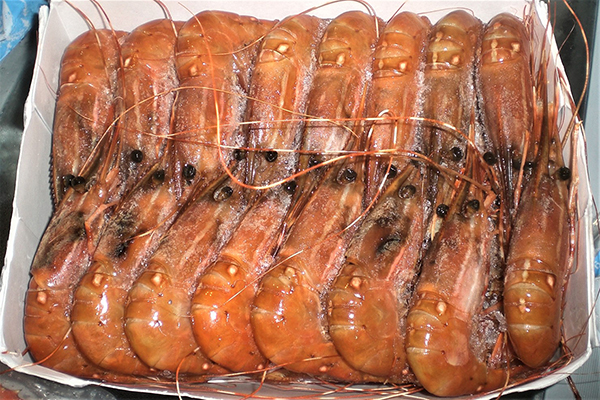
Essential oils (EOs) are important plant extracts and have attracted much interest from scientists for their various biological activities, including anticancer, anti-obesity, antispasmodic effects and others. They also have the potential to replace chemical preservatives in food preservation due to their antibacterial, antiviral, antifungal, and antioxidant effects. Studies have demonstrated the efficiency of EOs to inhibit the growth of pathogens and other spoilers and extend the shelf life of seafood.
And as they are derived from plants, they are generally recognized as safe (GRAS) by the United States Food and Drug Administration (USFDA). However, essential oils are very complex, because they are composed of at least 50 components, and it is difficult to predict the susceptibility of a microorganism to specific kinds of EOs. Therefore, it is necessary to study the formula of the extracts on different food products individually.
To extend the shelf life of shrimp, it is important to inhibit both the development of melanosis and the growth of bacteria. The inhibitory effect of some kinds of EOs on bacteria growth in seafood has been reported, but studies about the effect of EOs on protein degradation and melanosis development of Pacific white shrimp (Litopenaeus vannamei) are scant.
This article – summarized from the original publication [Qian, Y-F. et al. 2022. In-Vitro Study on the Antibacterial and Antioxidant Activity of Four Commercial Essential Oils and In-Situ Evaluation of Their Effect on Quality Deterioration of Pacific White Shrimp (Litopenaeus vannamei) during Cold Storage. Foods 2022, 11(16), 2475] – discussed the results of in vitro and in situ evaluations of the antibacterial and anti-melanosis activity of several essential oils – including oregano (Origanum vulgare), wild orange (Citrus sinensis), tea tree (Melaleuca alternifolia) and clove (Eugenia caryophyllata) – and the efficiency of these essential oils on the preservation of shrimp and propose a possible freshness-maintaining mechanism.
Study setup
Litopenaeus vannamei (16–20 grams each) shrimp were purchased live from a local market near Luchaogang Port (Shanghai, China). Upon arrival at the laboratory, the animals were immersed into an ice slurry and washed, and randomly separated into four groups.
Oregano essential oil (OEO) and clove leaf essential oil (CLEO) were used to preserve Pacific white shrimp during cold storage. A compound preserving solution was prepared with 2 percent OEO and 2 percent CLEO at a ratio of 1:1. Then the shrimp were immersed into the essential oils for 5 minutes before draining. The four treatments tested were (1) Con (control): treated with sterilized water; (2) OEO: treated with 2 percent OEO; (3) CLEO: treated with 2 percent CLEO; (4) OEO + CLEO: treated with 1 percent OEO + 1 percent CLEO. After a cold storage period, shrimp samples were collected and analyzed for various parameters.
For detailed information on the experimental design, sample preparation and application of preservatives; microbiological analyses; weight loss, melanosis and colorimetric determinations and other tests, refer to the original publication.
Are alternative shelf life-extending protocols effective on seafood products?
Results and discussion
Our results for microbiological growth show the changes of total viable counts, psychrotrophic [bacteria that grow at less than 7 degrees-C] bacterial counts, and hydrogen sulfide (H2S)-producing bacterial counts of shrimp treated with essential oils (Fig. 1A–C). The initial total viable counts (TVCs) of the four groups were close to each other, and the total viable counts of all groups were all increased during storage. The essential oil treatment group was significantly lower than the control group.
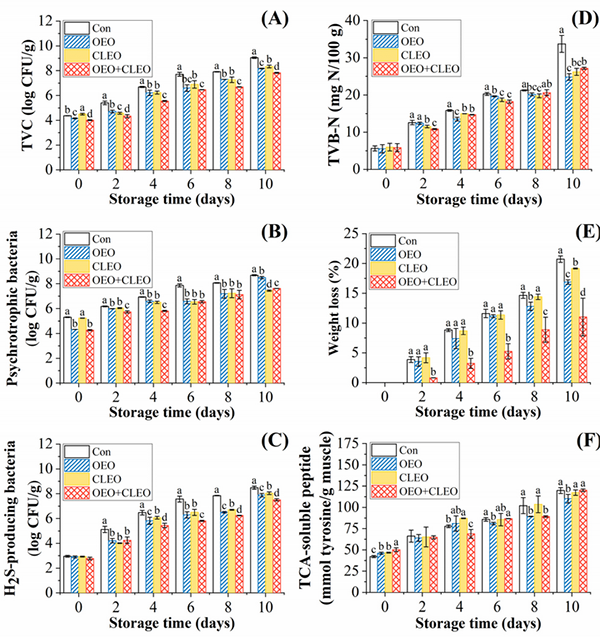
The essential oils had an obvious combined and enhanced effect of bacteriostasis [bacterial inhibition without destruction], which was consistent with the results of earlier in vitro experiments, and the shelf life of shrimp was prolonged by about 4 days by the OEO + CLEO.
The spoilage of shrimp during refrigerated storage was mainly attributed to the proliferation of psychrotrophic bacteria. During the storage period, the samples treated with essential oils were always lower than the control group, indicating its inhibitory effect on the growth of psychrotrophic bacteria.
The changes of H2S-producing bacterial counts of Pacific white shrimp during storage are shown in Fig. 1C. Shewanella species, including S. putrefaciens and S. baltica are reported to be the predominant H2S-producing bacteria in shrimp, which has the capacity to produce various off-odor compounds. The initial counts of H2S-producing bacteria in the four groups were close to each other, but the increase in samples treated with essential oils was retarded. CLEO displayed a slightly lower effect of bacteriostasis than OEO, in accordance with the in vitro measurement. However, the combination of the two essential oils showed the highest antibacterial effect, indicating that there was a synergistic effect.
Fig. 1E showed the weight loss of Pacific white shrimp treated with essential oils during storage. The weight loss is mainly related with the drip loss of muscle, due to the decomposition, denaturation, or oxidation of proteins. The capacity to prevent weight loss of products is an important indicator to evaluate the efficiency of preservatives. Our results showed that all samples treated with essential oils had lower weight loss than the control. Among the three treated samples, the samples treated with OEO + CLEO had the lowest weight loss, indicating that OEO + CLEO could inhibit the changes of protein effectively.
Regarding the colorimetric measurement, the whiteness of cephalothorax and abdomen of Pacific white shrimp are observed in Figs. 2A and 2B. The whiteness value of all groups showed a decreasing tendency during storage. The shrimp treated with essential oils had higher whiteness values than the control, especially the samples treated with CLEO and OEO + CLEO. The CLEO was more helpful to maintain the whiteness value of shrimp cephalothorax, due to its higher antioxidant activity.
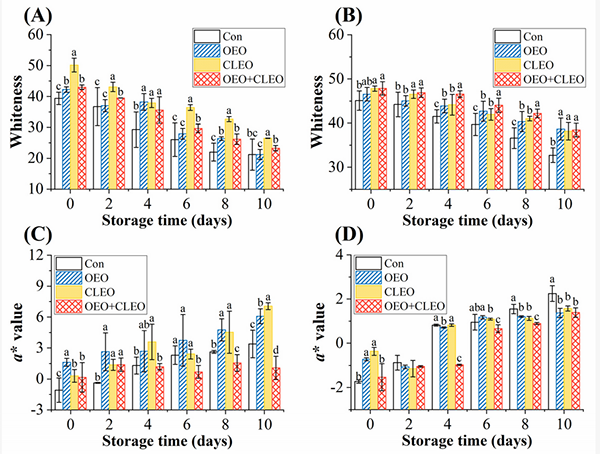
The redness (a*) value of shrimp cephalothorax and abdomen both increased during the storage (Figs. 2C and 2D). The increase of the a* value of shrimp cephalothorax was much faster than that of the shrimp abdominal section. The samples treated with OEO + CLEO were lower than other groups. The increase of redness value could be related with the decomposition of astaxanthin-protein complexes and the release of astaxanthin monomers.
For the melanosis ratio, Fig. 3 shows photos of Pacific white shrimp during storage. Melanosis usually starts from the cephalothorax and then spreads to the abdomen and the tail. The melanosis ratio of the control was significantly higher than the treated samples throughout the storage period, indicating more black spots occurred on the whole shrimp. The melanosis ratio was negatively correlated with the changes of whiteness values. CLEO seemed to have a stronger inhibitory effect on melanosis than OEO, as the shrimp treated with OEO had a higher melanosis ratio. The combined treatment of OEO and CLEO displayed the lowest melanosis ratio, indicating that the two essential oils had a synergetic effect on inhibiting the spread of black spots.
![Fig. 3: Photographs (A) and changes of melanosis ratio (B) and the enzyme polyphenol oxidase, PPO [involved in melanosis] activity (C) of refrigerated Pacific white shrimp treated by OEO and CLEO at 4 degrees-C. Data are shown as mean ± SD (n = 3). Different lowercase letters indicate significant differences (p < 0.05) among different treatments within the same storage time. Adapted from the original.](https://www.globalseafood.org/wp-content/uploads/2022/08/YANG-Fig-3_960.png)
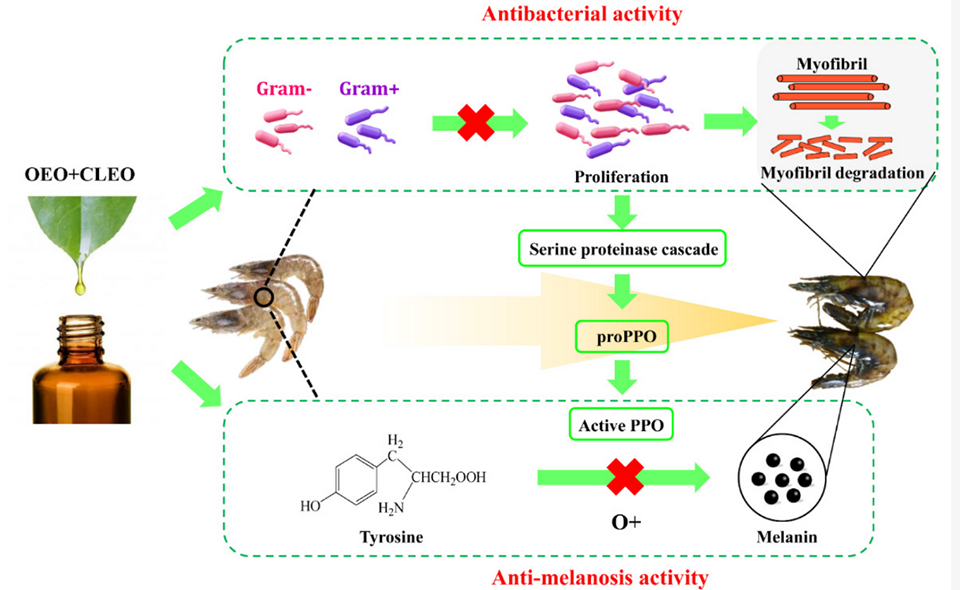
Perspectives
Our research described the ability of essential oil treatments to extend the shelf life of Pacific white shrimp. We found that CLEO and OEO had a greater antioxidant and antibacterial effect than WOEO and TTEO. Therefore, CLEO and OEO were applied to preserve shrimp for an in-situ study. The results indicated that both CLEO and OEO could inhibit the quality deterioration of shrimp effectively. The CLEO displayed higher antioxidant activity, as well as a higher inhibitory effect on PPO activity and melanosis, while OEO had a greater effect on preventing the increase of bacterial growth, weight loss and other variables.
Our study showed that the combination of CLEO and OEO enhanced their antioxidant and antibacterial effect, and could maintain the quality of shrimp most effectively, consequently prolonging the microbiological shelf-life by about 4 days. Our data shows the potential to use EOs in the preservation of Pacific white shrimp, and the convenience of this method for potential industrial application.
Now that you've reached the end of the article ...
… please consider supporting GSA’s mission to advance responsible seafood practices through education, advocacy and third-party assurances. The Advocate aims to document the evolution of responsible seafood practices and share the expansive knowledge of our vast network of contributors.
By becoming a Global Seafood Alliance member, you’re ensuring that all of the pre-competitive work we do through member benefits, resources and events can continue. Individual membership costs just $50 a year.
Not a GSA member? Join us.
Author
-
Dr. Sheng-Ping Yang
Corresponding author
College of Food Science & Technology, Shanghai Ocean University, Shanghai 201306, China; and Shanghai Engineering Research Center of Aquatic Product Processing & Preservation, Shanghai 201306, China
Tagged With
Related Posts
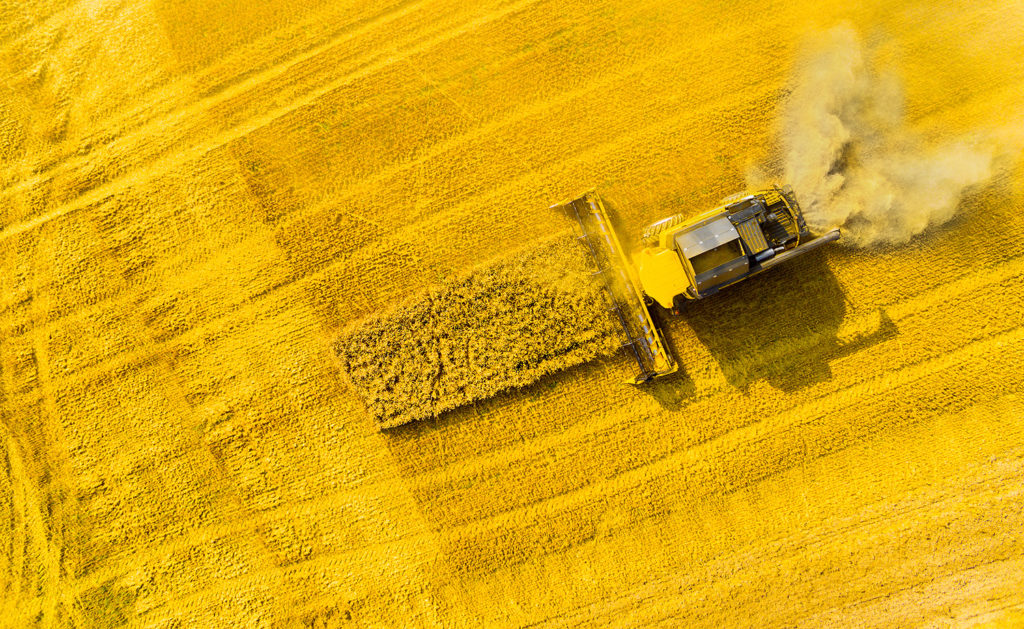
Aquafeeds
A push for rapeseed as a viable aquafeed ingredient
One Germany-based company says rapeseed protein concentrate, or RPC, can help aquafeed manufacturers meet growing demand.
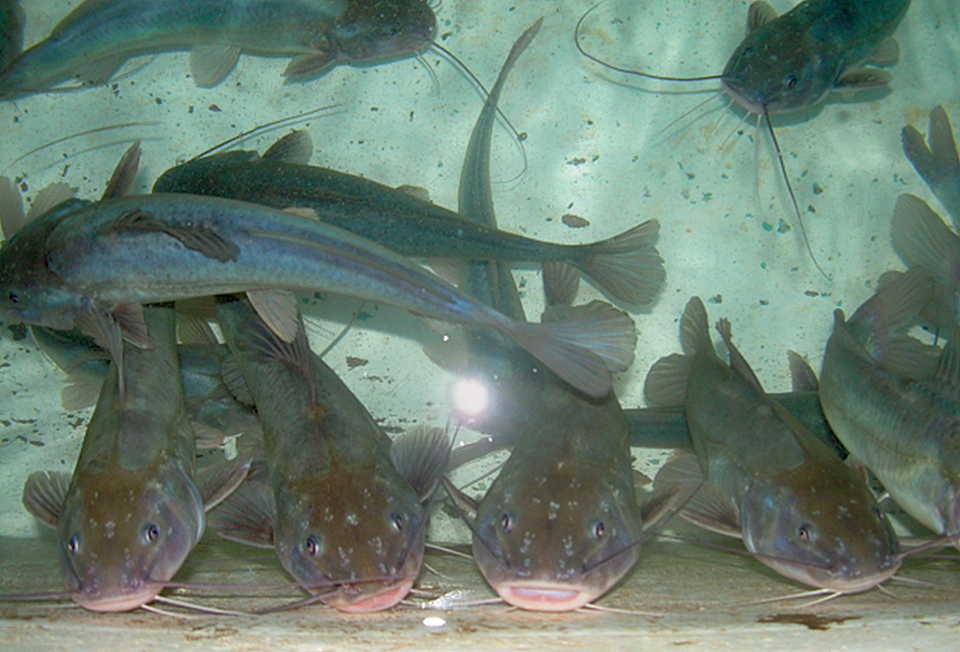
Health & Welfare
Clove oil, eugenol effective anesthetics for silver catfish
Clove oil and eugenol have been recommended and used as anesthetics for several fish species. Moreover, these products have received the attention of researchers because of their chemo-preventive effects, as well as their anti-inflammatory and antioxidant properties.
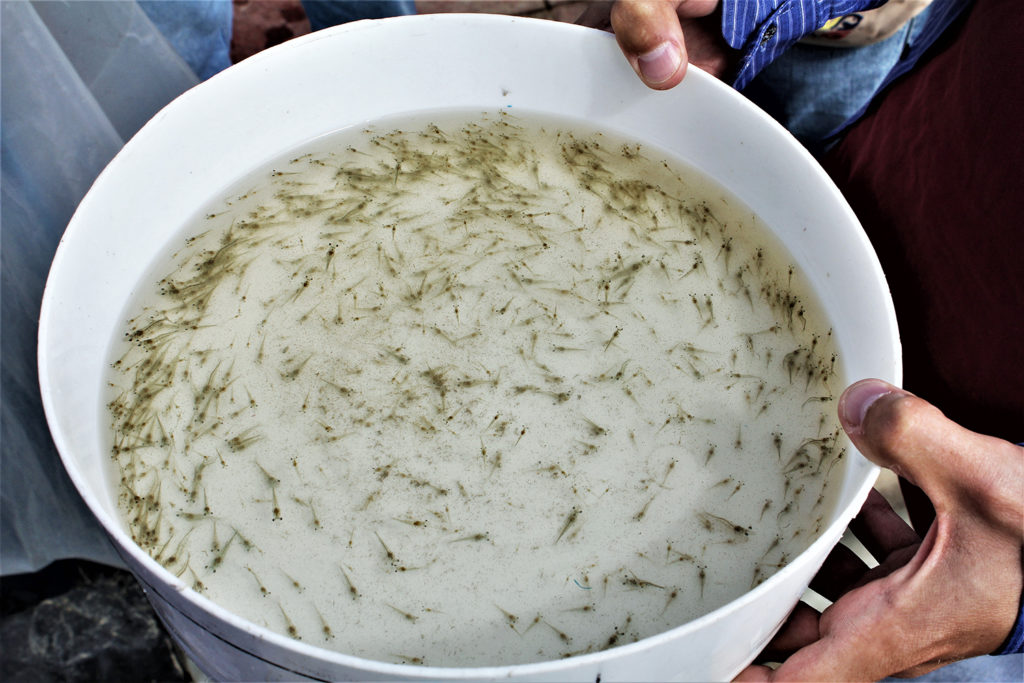
Health & Welfare
Efficacy of natural products and antibiotics in shrimp hatcheries
This study evaluated through in vitro analyses the antimicrobial effectiveness of natural products used for P. vannamei bacterial diseases and antibiotics against pathogenic Vibrio strains circulating in Ecuadorian hatcheries.
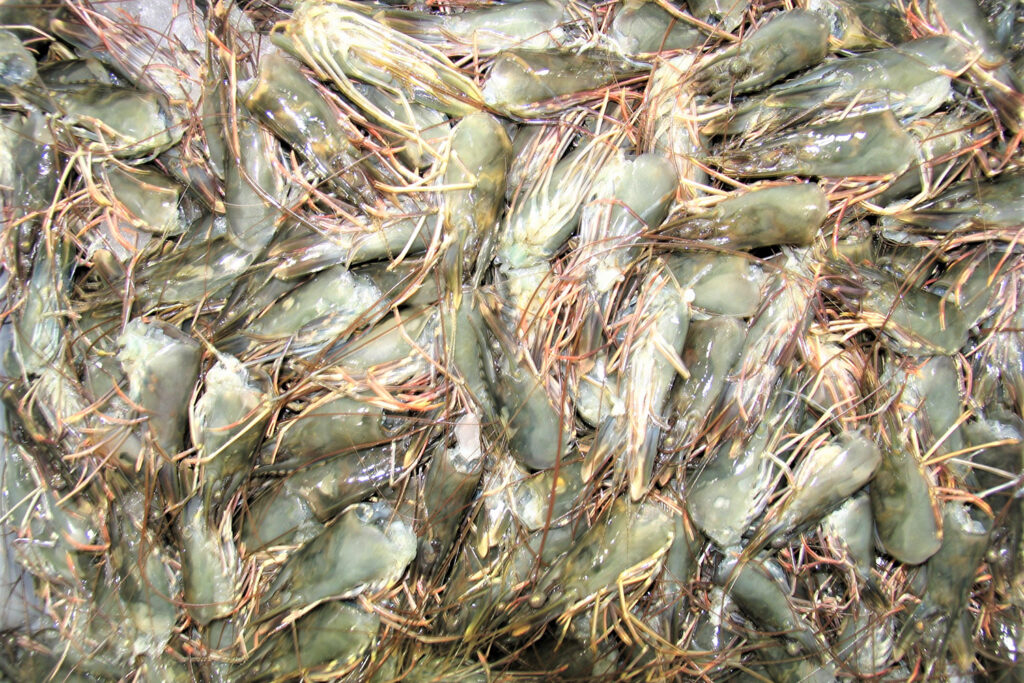
Aquafeeds
Black tiger shrimp processing waste can be converted into a value-added powder
Philippines study finds shrimp processing waste can be turned into nutritious powdered ingredients for soups or seasonings.



